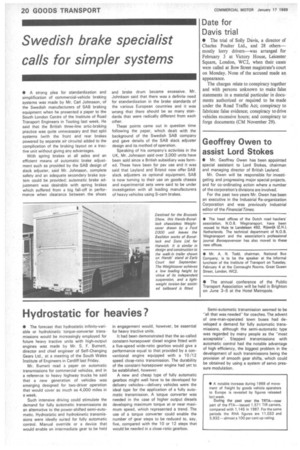Hydrostatic for heavies?
Page 22

If you've noticed an error in this article please click here to report it so we can fix it.
• The forecast that hydrostatic infinity-variable or hydrokinetic torque-converter transmissions would be increasingly employed for future heavy tractive units with high-output engines was made by Mr. S. F. Burnett, director and chief engineer of Self-Changing Gears Ltd., at a meeting of the South Wales Institute of Engineers in Cardiff last Friday.
Mr. Burnett read a paper on automatic transmissions for commercial vehicles, and in a reference to heavy highway trucks he said that a new generation of vehicles was emerging designed for two-driver operation that would cover as much as 4,000 miles in a week.
Such intensive driving could stimulate the demand for fully automatic transmissions as an alternative to the power-shifted semi-automatic. Hydrostatic and hydrokinetic transmissions were ideally suited for fully automatic control. Manual override or a device that would enable an intermediate gear to be held in engagement would, however, be essential for heavy tractive units.
It had been demonstrated that the so-called constant-horsepower diesel engine fitted with a five-speed wide-ratio gearbox would give a performance equal to that provided by a conventional engine equipped with a 10/12 speed close-ratio transmission, The durability of the constant-horsepower engine had yet to be established, however.
A new and cheap type of fully automatic gearbox might well have to be developed for delivery vehicles—delivery vehicles were the ideal type for the application of a fully automatic transmission. A torque converter was needed in the case of higher output diesels developing maximum torque at or near maximum speed, which represented a trend. The use of a torque converter could enable the number of gear steps to be reduced to, say, five, compared with the 10 or 12 steps that would be needed in a close-ratio gearbox.
Semi-automatic transmission seemed to be "all that was needed" for coaches. The advent of one-man-operated town buses had developed a demand for fully automatic transmissions, although the semi-automatic type was regarded by many people as the "most acceptable". Stepped transmissions with automatic control had the notable advantage of high .efficiency, the biggest problem in the development of such transmissions being the provision of smooth gear shifts, which could be obtained by using a system of servo pressure modulation.








































































































